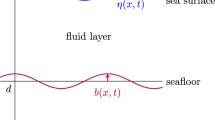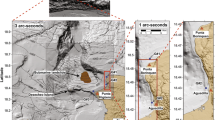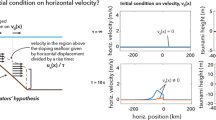Abstract
We have developed a new, unified modeling technique for the total simulation of seismic waves, ocean acoustic waves, and tsunamis resulting from earthquakes, based on a finite difference method simulation of the 3D equations of motion. Using the equilibrium between the pressure gradient and gravity in these equations, tsunami propagation is naturally incorporated in the simulation based on the equations of motion. The performance of the parallel computation for the newly developed tsunami-coupled equations using a domain partitioning procedure shows a high efficiency coefficient with a large number of CPU cores. The simulation results show how the near-field term associated with seismic waves produced by shallow earthquakes leads to a permanent coseismic deformation of the ground surface, which gives rise to the initial tsunami on the sea surface. Propagation of the tsunami along the sea surface as a gravity wave, and ocean acoustic waves in seawater with high-frequency multiple P-wave reflections between the free surface and sea bottom, are also clearly demonstrated by the present simulations. We find a good agreement in the tsunami waveform between our results and those obtained by other simulations based on an analytical model and the Navier–Stokes equations, demonstrating the effectiveness of the tsunami-coupling simulation model. Based on this simulation, we show that the ratio of the amplitude of ocean acoustic waves to the height of the tsunami, both of which are produced by the earthquake, strongly depends on the rise time of the earthquake rupture. This ratio can be used to obtain a more detailed understanding of the source rupture processes of subduction zone earthquakes, and for implementing an improved tsunami alert system for slow tsunami earthquakes.











Similar content being viewed by others
References
Chew, W. C., and Liu, Q. H. (1996), Perfectly matched layers for elastodynamics: A new absorbing boundary condition, J. Comp. Acoust. 4, 341–359, doi:10.1142/S0218396X96000118.
Cerjan, C., Kosloff, D., Kosloff, R., and Reshef, M. (1985), A nonreflecting boundary condition for discrete acoustic and elastic wave equations, Geophysics 50, 705–708, doi:10.1190/1.441945.
Clayton, R., and Engquist, B. (1977), Absorbing boundary conditions for acoustic and elastic wave equations, Bull. Seism. Soc. Am. 67, 1529–1540.
Comer, R. P. (1984), The tsunami mode of a flat earth and its excitation by earthquake sources, Geophys. J. R. Astr. Soc. 77, 1–27, doi:10.1111/j.1365-246X.1984.tb01923.x.
Festa, G., and Nielsen, S. (2003), PML absorbing boundaries, Bull. Seism. Soc. Am. 93, 891–903, doi:10.1785/0120020098.
Furumura, T., and Chen, L. (2005), Parallel simulation of strong ground motions during recent and historical damaging earthquakes in Tokyo, Japan, Parallel Comp. 31, 149–165, doi:10.1016/j.parco.2005.02.003.
Furumura, T., and Saito, T. (2009), Integrated ground motion and tsunami simulation for the 1944 Tonankai earthquake using high-performance supercomputers, J. Disast. Res. 4, 118–126.
Furumura, T., Imai, K., and Maeda, T. (2011), A revised tsunami source model for the 1707 Hoei earthquake and simulation of tsunami inundation of Ryujin Lake, Kyushu, Japan, J. Geophys. Res. 116, B02308, doi:10.1029/2010JB007918
Graves, R. W. (1996), Simulating seismic wave propagation in 3D elastic media using staggered-grid finite differences, Bull. Seism. Soc. Am. 86, 1091–1106.
Hayashi, K., Burns, D. R., and Toksöz, M. N. (2001), Discontinuous-grid finite-difference seismic modeling including surface topography, Bull. Seism. Soc. Am. 91, 1750–1764, doi:10.1785/0120000024.
Hino, R., Tanioka, Y., Kanazawa, T., Sakai, S., Nishino, M., and Suyehiro, K. (2001), Micro-tsunami from a local interpolate earthquake detected by cabled offshore tsunami observation in northeastern Japan, Geophys. Res. Lett., 28(18), 3533–3536, doi:10.1029/2001GL013297.
Imai, K., Satake, K., and Furumura, T. (2010) Amplification of tsunami heights by delayed rupture of great earthquakes along the Nankai trough, Earth Planets Space, 62, 427–432, doi: 10.5047/eps.2009.12.005.
Kajiura, K. (1963), The leading wave of a tsunami, Bull. Earthq. Res. Inst. 41, 535–571.
Kikuchi, M., Yamanaka, Y., Abe, K., and Morita, Y. (1999), Source rupture process of the Papua New Guinea earthquake of July 17, 1998 inferred from teleseismic body waves, Earth Planets Space 51, 1319–1324.
Komatitsch, D. and Martin R. (2007), An unsplit convolutional perfectly matched layer improved at grazing incidence for the seismic wave equation, Geophysics 72, SM155–SM167, doi:10.1190/1.2757586.
Kristek, J., Moczo, P., and Galis, M. (2009), A brief summary of some PML formulations and discretizations for the velocity-stress equation of seismic motion, Stud. Geophys. Geod. 53, 459–474, doi:10.1007/s11200-009-0034-6.
Landau, L. D. and Lifshitz, E. M. (1959), Fluid Mechanics, Pergamon Press, 536 pp.
Levander, A. R. (1988), Fourth-order finite-difference P-SV seismograms, Geophysics 53, 11, 1425–1536, doi:10.1190/1.1442422.
Maeda, T., Furumura, T., Sakai, S., and Shinohara, M. (2011), Significant tsunami observed at the ocean-bottom pressure gauges at 2011 Off the Pacific Coast of Tohoku Earthquake, Earth Planets Space, 63, doi:10.5047/eps.2011.06.005, in press.
Marcinkovich, C. and Olsen, K. (2003), On the implementation of perfectly matched layers in a three-dimensional fourth-order velocity-stress finite difference scheme, J. Geophys. Res. 108(B5), 2276, doi:10.1029/2002JB002235.
Matsumoto, H., and Kaneda, Y. (2009), Review of recent tsunami observation by offshore cabled observatory, J. Disast. Res. 4, 489–497.
Mavroeidis, G. P. and Papageorgiou A. S. (2003), A mathematical representation of near-field ground motions, Bull. Seism. Soc. Am. 93, 1099–1131, doi:10.1785/0120020100.
Meinig, C., Stalin, S.E, Nakamura, A. I., González, F., and Milburn, H. G. (2005), Technology developments in real-time tsunami measuring, monitoring and forecasting, in Oceans 2005 MTS/IEEE, 19–23 September 2005, Washington, D.C.
Moczo, P., Robertsson, J. O. A., and Einster, L. (2007), The finite-difference time-domain method for modeling of seismic wave propagation, in Advances in Wave Propagation in Heterogeneous Earth, eds., R.-S. Wu and V. Maupin, Advances in Geophysics 48, doi:10.1016/S0065-2687(06)48008-0.
Nakamura, T., Takenaka, H., Okamoto, T., Kaneda, Y. (2011), A study of the finite difference solution for 3D seismic wavefields near a fluid-solid interface, Zisin2 63, 187–194 (in Japanese).
Nosov, M. A., and Kolesov, S. V. (2007), Elastic oscillations of water column in the 2003 Tokachi-oki tsunami source: in-situ measurements and 3-D numerical modeling, Nat. Hazards Earth Syst. Sci. 7, 243–249, doi:10.5194/nhess-7-243-2007
Novikova, T., Wen, K.-L., and Huang, B.-S. (2002), Analytical model for gravity and Rayleigh-wave investigation in the layered ocean-earth structure, Bull. Seism. Soc. Am. 92, 723–738, doi:10.1785/0120000272.
Okal, E. A., (2008), The generation of T waves by earthquakes, Adv. Geohys., 49, 1–65, doi:10.1016/S0065-2687(07)49001-X.
Okada, Y. (1985), Surface deformation due to shear and tensile faults in a half-space, Bull. Seism. Soc. Am. 75, 1135–1154.
Okamoto, T. and Takenaka, H. (2005), Fluid-solid boundary implementation in the velocity-stress finite-difference method, Zisin2 57, 355–364 (in Japanese with English Abstract).
Ohmachi, T., Tsukiyama, H., and Matsumoto H. (2001), Simulation of tsunami induced by dynamic displacement of seabed due to seismic faulting, Bull. Seism. Soc. Am. 91, 189801909, 2001.
Saito, T., and Furumura, T. (2009), Three-dimensional simulation of tsunami generation and propagation: Application to intraplate events, J. Geophys. Res. 114, B02307, doi:10.1029/2007JB005523.
Saito, T., Satake, K., and Furumura, T. (2010), Tsunami waveform inversion including dispersive waves: the 2004 earthquake off Kii Peninsula, Japan, J. Geophys. Res. 115, B06303, doi:10.1029/2009JB006884.
Takenaka, H., Nakamura, T., Okamoto, T., and Kaneda, Y. (2009), A unified approach implementing land and ocean-bottom topographies in the staggered-grid finite-difference method for seismic wave modeling, in Proc. 9th SEGJ Int. Symp., CD-ROM Paper 37 (4 pages).
Tanioka, Y. and Seno, T. (2001), Sediment effect on tsunami generation of the 1896 Sanriku tsunami earthquake, Geophys. Res. Lett. 28, 3389–3392, doi:10.1029/2001GL013149.
Tsushima, H., Hino, R., Fujimoto, H., Tanioka, Y., and Imamura, F. (2009), Near-field tsunami forecasting from cabled ocean bottom pressure data, J. Geophys. Res. 114, B06309, doi:10.1029/2008JB005988.
Acknowledgments
We would like to thank Eiichi Fukuyama and three anonymous reviewers for their helpful comments on revising the manuscript. The computations in this study were performed in part at the Earth Simulator at the Japan Agency for Marine-Earth Science and Technology and in part on the HA8000 system in the University of Tokyo. This study was supported by the research project “Improvements of strong ground motion and tsunami simulation accuracy for application of realistic disaster prevention of the Nankai-Trough mega-thrust earthquake” of the Ministry of Education, Culture and Sports, Science and Technology.
Author information
Authors and Affiliations
Corresponding author
Additional information
Special issue on “Earthquake and Tsunami Science: Towards Disaster Prevention”.
Rights and permissions
About this article
Cite this article
Maeda, T., Furumura, T. FDM Simulation of Seismic Waves, Ocean Acoustic Waves, and Tsunamis Based on Tsunami-Coupled Equations of Motion. Pure Appl. Geophys. 170, 109–127 (2013). https://doi.org/10.1007/s00024-011-0430-z
Received:
Revised:
Accepted:
Published:
Issue Date:
DOI: https://doi.org/10.1007/s00024-011-0430-z




